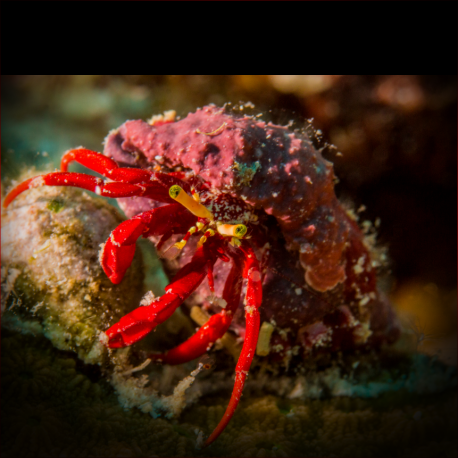More info
Datasheet
| Minimum Tank Size | 50 litres / 13.21 US gallons |
| Maximum Size | 4.0cm / 1.57inches |
| Reef Compatible | Always reef safe |
| Temperament | Mostly peaceful but might be aggressive towards similar species |
| Temperature | 22.2°C / 71.96°F - 25.6°C / 78.08°F |
| Specific Gravity | 1.020-1.025 |
| Carbonate Hardness | 8-12 |
| pH | 8.1-8.4 |
General Description
The Scarlet hermit crab, scientifically known as Paguristes cadenati, belongs to the Paguroidea family. These hermit crabs are relatively small, typically reaching a maximum size of 4.0cm. They are native to the Mexican Gulf.
Aquarium Suitability
Scarlet hermit crabs are generally suitable for most aquariums. They are considered hardy creatures and can thrive in a tank with a minimum size of 50 liters. They are compatible with reef setups and are known to be reef safe.
Demands, Care, and Hardiness
These hermit crabs are low-maintenance and easy to care for. They thrive in water with a temperature ranging from 22.2-25.6°C, a pH between 8.1-8.4, a specific gravity of 1.020-1.025, and a carbonate hardness of 8-12 dKH.
Reef Suitability
Scarlet hermit crabs are always reef safe and can be a good addition to reef aquariums without causing harm to corals or other reef inhabitants.
Aquarium Setup
When setting up an aquarium for Scarlet hermit crabs, it is essential to provide them with enough space and hiding spots. They require a varied diet consisting of detritus, small crustaceans like krill and mysis, macroalgae such as seaweed or nori, and microalgae like spirulina.
Behaviour
These hermit crabs have a mostly peaceful temperament but can display aggression towards similar species if insufficient space or food is provided. They are known for their scavenging behavior and their need for new shells to grow.
Feeding and Diet
In captivity, Scarlet hermit crabs feed on detritus, small crustaceans, macroalgae, and microalgae. Providing a diverse diet will help keep them healthy and active in the aquarium.
Habitat and Distribution
Paguristes cadenati, the Scarlet hermit crab, is primarily found in the Mexican Gulf. Their natural habitat includes rocky areas where they feed on zooplankton and other small organisms found on the rocks.

